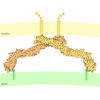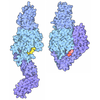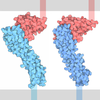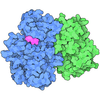[English] 日本語
 Yorodumi
Yorodumi- EMDB-60766: HL-type bispecific diabody Ex3 composed of 528 and OKT3 Fvs in te... -
+ Open data
Open data
- Basic information
Basic information
| Entry |  | |||||||||
|---|---|---|---|---|---|---|---|---|---|---|
| Title | HL-type bispecific diabody Ex3 composed of 528 and OKT3 Fvs in ternary complex with sEGFR and CD3gamma-epsilon (middle conformation) | |||||||||
 Map data Map data | sharpened map | |||||||||
 Sample Sample |
| |||||||||
 Keywords Keywords | bispecific antibody / diabody / EGFR / CD3 / ternary complex / HL / Ex3 / 528 / OKT3 / ANTITUMOR PROTEIN / ANTITUMOR PROTEIN-IMMUNE SYSTEM complex | |||||||||
| Function / homology |  Function and homology information Function and homology informationregulation of lymphocyte apoptotic process / gamma-delta T cell receptor complex / T cell anergy / positive regulation of cell-cell adhesion mediated by integrin / positive regulation of T cell anergy / gamma-delta T cell activation / CD4-positive, alpha-beta T cell proliferation / negative thymic T cell selection / positive regulation of CD4-positive, alpha-beta T cell proliferation / alpha-beta T cell receptor complex ...regulation of lymphocyte apoptotic process / gamma-delta T cell receptor complex / T cell anergy / positive regulation of cell-cell adhesion mediated by integrin / positive regulation of T cell anergy / gamma-delta T cell activation / CD4-positive, alpha-beta T cell proliferation / negative thymic T cell selection / positive regulation of CD4-positive, alpha-beta T cell proliferation / alpha-beta T cell receptor complex / positive thymic T cell selection / signal complex assembly / multivesicular body, internal vesicle lumen / negative regulation of cardiocyte differentiation / Shc-EGFR complex / positive regulation of protein kinase C signaling / Inhibition of Signaling by Overexpressed EGFR / epidermal growth factor receptor activity / EGFR interacts with phospholipase C-gamma / regulation of peptidyl-tyrosine phosphorylation / epidermal growth factor binding / response to UV-A / PLCG1 events in ERBB2 signaling / positive regulation of cell-matrix adhesion / smoothened signaling pathway / ERBB2-EGFR signaling pathway / T cell receptor complex / morphogenesis of an epithelial fold / PTK6 promotes HIF1A stabilization / ERBB2 Activates PTK6 Signaling / digestive tract morphogenesis / Signaling by EGFR / Translocation of ZAP-70 to Immunological synapse / Phosphorylation of CD3 and TCR zeta chains / positive regulation of interleukin-4 production / intracellular vesicle / negative regulation of epidermal growth factor receptor signaling pathway / eyelid development in camera-type eye / establishment or maintenance of cell polarity / dendrite development / cerebral cortex cell migration / protein insertion into membrane / ERBB2 Regulates Cell Motility / protein tyrosine kinase activator activity / alpha-beta T cell activation / Respiratory syncytial virus (RSV) attachment and entry / Generation of second messenger molecules / Signaling by ERBB4 / FCGR activation / PI3K events in ERBB2 signaling / immunological synapse / positive regulation of phosphorylation / Co-inhibition by PD-1 / positive regulation of peptidyl-serine phosphorylation / Estrogen-dependent nuclear events downstream of ESR-membrane signaling / hair follicle development / MAP kinase kinase kinase activity / Role of phospholipids in phagocytosis / GAB1 signalosome / positive regulation of G1/S transition of mitotic cell cycle / embryonic placenta development / salivary gland morphogenesis / T cell receptor binding / T cell costimulation / Signaling by ERBB2 / positive regulation of T cell proliferation / TFAP2 (AP-2) family regulates transcription of growth factors and their receptors / GRB2 events in EGFR signaling / transmembrane receptor protein tyrosine kinase activity / SHC1 events in EGFR signaling / EGFR Transactivation by Gastrin / positive regulation of calcium-mediated signaling / GRB2 events in ERBB2 signaling / positive regulation of interleukin-2 production / SHC1 events in ERBB2 signaling / FCGR3A-mediated IL10 synthesis / cell surface receptor protein tyrosine kinase signaling pathway / ossification / basal plasma membrane / cellular response to epidermal growth factor stimulus / cerebellum development / T cell activation / positive regulation of DNA repair / positive regulation of DNA replication / epithelial cell proliferation / Signal transduction by L1 / positive regulation of epithelial cell proliferation / positive regulation of protein localization to plasma membrane / negative regulation of smoothened signaling pathway / FCGR3A-mediated phagocytosis / cellular response to amino acid stimulus / NOTCH3 Activation and Transmission of Signal to the Nucleus / apoptotic signaling pathway / phosphatidylinositol 3-kinase/protein kinase B signal transduction / cellular response to estradiol stimulus / clathrin-coated endocytic vesicle membrane / EGFR downregulation / calcium-mediated signaling / Signaling by ERBB2 TMD/JMD mutants / cell-cell adhesion Similarity search - Function | |||||||||
| Biological species | synthetic construct (others) /  Homo sapiens (human) Homo sapiens (human) | |||||||||
| Method | single particle reconstruction / cryo EM / Resolution: 3.64 Å | |||||||||
 Authors Authors | Sato K / Uehara S / Tsugita A / Matsui T / Asano R / Makabe K / Yokoyama T / Tanaka Y | |||||||||
| Funding support |  Japan, 1 items Japan, 1 items
| |||||||||
 Citation Citation |  Journal: Cell Rep / Year: 2025 Journal: Cell Rep / Year: 2025Title: Bispecific antibody-antigen complex structures reveal activity enhancement by domain rearrangement. Authors: Kyohei Sato / Shiro Uehara / Atsushi Tsugita / Mayuka Ishii / Shieru Ishiyama / Atsushi Maejima / Ishin Nakahara / Misae Nazuka / Takashi Matsui / Gatsogiannis Christos / Takeshi Yokoyama / ...Authors: Kyohei Sato / Shiro Uehara / Atsushi Tsugita / Mayuka Ishii / Shieru Ishiyama / Atsushi Maejima / Ishin Nakahara / Misae Nazuka / Takashi Matsui / Gatsogiannis Christos / Takeshi Yokoyama / Izumi Kumagai / Koki Makabe / Ryutaro Asano / Yoshikazu Tanaka /   Abstract: Bispecific antibodies (BsAbs) have been developed as anti-cancer drugs that accumulate activated T cells on cancer cells by bridging the antigens present in each cell. Ex3 is a diabody-type BsAb ...Bispecific antibodies (BsAbs) have been developed as anti-cancer drugs that accumulate activated T cells on cancer cells by bridging the antigens present in each cell. Ex3 is a diabody-type BsAb composed of an anti-epidermal growth factor receptor (EGFR) antibody and an anti-CD3 antibody. In the design of Ex3, the LH-type domain order (Ex3LH) is shown to have more than 100-fold greater anti-cancer activity than the HL-type domain order (Ex3HL). To understand this phenomenon of activity enhancement by domain-order rearrangement, we report here cryoelectron microscopy (cryo-EM) structures of both Ex3HL and Ex3LH in complex with EGFR and CD3. A structural comparison of the HL and LH types reveals that the domain rearrangement leads to drastic structural changes and that the avoidance of steric hindrance by a favorable bridging angle on the cell surface is the fundamental mechanism for this activity enhancement. | |||||||||
| History |
|
- Structure visualization
Structure visualization
| Supplemental images |
|---|
- Downloads & links
Downloads & links
-EMDB archive
| Map data |  emd_60766.map.gz emd_60766.map.gz | 110 MB |  EMDB map data format EMDB map data format | |
|---|---|---|---|---|
| Header (meta data) |  emd-60766-v30.xml emd-60766-v30.xml emd-60766.xml emd-60766.xml | 23.8 KB 23.8 KB | Display Display |  EMDB header EMDB header |
| FSC (resolution estimation) |  emd_60766_fsc.xml emd_60766_fsc.xml | 12.7 KB | Display |  FSC data file FSC data file |
| Images |  emd_60766.png emd_60766.png | 51.1 KB | ||
| Filedesc metadata |  emd-60766.cif.gz emd-60766.cif.gz | 7.1 KB | ||
| Others |  emd_60766_half_map_1.map.gz emd_60766_half_map_1.map.gz emd_60766_half_map_2.map.gz emd_60766_half_map_2.map.gz | 200.7 MB 200.7 MB | ||
| Archive directory |  http://ftp.pdbj.org/pub/emdb/structures/EMD-60766 http://ftp.pdbj.org/pub/emdb/structures/EMD-60766 ftp://ftp.pdbj.org/pub/emdb/structures/EMD-60766 ftp://ftp.pdbj.org/pub/emdb/structures/EMD-60766 | HTTPS FTP |
-Validation report
| Summary document |  emd_60766_validation.pdf.gz emd_60766_validation.pdf.gz | 900.3 KB | Display |  EMDB validaton report EMDB validaton report |
|---|---|---|---|---|
| Full document |  emd_60766_full_validation.pdf.gz emd_60766_full_validation.pdf.gz | 899.8 KB | Display | |
| Data in XML |  emd_60766_validation.xml.gz emd_60766_validation.xml.gz | 21.4 KB | Display | |
| Data in CIF |  emd_60766_validation.cif.gz emd_60766_validation.cif.gz | 27.8 KB | Display | |
| Arichive directory |  https://ftp.pdbj.org/pub/emdb/validation_reports/EMD-60766 https://ftp.pdbj.org/pub/emdb/validation_reports/EMD-60766 ftp://ftp.pdbj.org/pub/emdb/validation_reports/EMD-60766 ftp://ftp.pdbj.org/pub/emdb/validation_reports/EMD-60766 | HTTPS FTP |
-Related structure data
| Related structure data |  9ip9MC  9ip7C  9ip8C  9ipaC  9ipbC  9ipcC  9ipdC  9ipeC M: atomic model generated by this map C: citing same article ( |
|---|---|
| Similar structure data | Similarity search - Function & homology  F&H Search F&H Search |
- Links
Links
| EMDB pages |  EMDB (EBI/PDBe) / EMDB (EBI/PDBe) /  EMDataResource EMDataResource |
|---|---|
| Related items in Molecule of the Month |
- Map
Map
| File |  Download / File: emd_60766.map.gz / Format: CCP4 / Size: 216 MB / Type: IMAGE STORED AS FLOATING POINT NUMBER (4 BYTES) Download / File: emd_60766.map.gz / Format: CCP4 / Size: 216 MB / Type: IMAGE STORED AS FLOATING POINT NUMBER (4 BYTES) | ||||||||||||||||||||||||||||||||||||
|---|---|---|---|---|---|---|---|---|---|---|---|---|---|---|---|---|---|---|---|---|---|---|---|---|---|---|---|---|---|---|---|---|---|---|---|---|---|
| Annotation | sharpened map | ||||||||||||||||||||||||||||||||||||
| Projections & slices | Image control
Images are generated by Spider. | ||||||||||||||||||||||||||||||||||||
| Voxel size | X=Y=Z: 0.788 Å | ||||||||||||||||||||||||||||||||||||
| Density |
| ||||||||||||||||||||||||||||||||||||
| Symmetry | Space group: 1 | ||||||||||||||||||||||||||||||||||||
| Details | EMDB XML:
|
-Supplemental data
-Half map: half map B
| File | emd_60766_half_map_1.map | ||||||||||||
|---|---|---|---|---|---|---|---|---|---|---|---|---|---|
| Annotation | half map B | ||||||||||||
| Projections & Slices |
| ||||||||||||
| Density Histograms |
-Half map: half map A
| File | emd_60766_half_map_2.map | ||||||||||||
|---|---|---|---|---|---|---|---|---|---|---|---|---|---|
| Annotation | half map A | ||||||||||||
| Projections & Slices |
| ||||||||||||
| Density Histograms |
- Sample components
Sample components
-Entire : HL-type bispecific antibody Ex3 composed of 528 and OKT3 Fvs in t...
| Entire | Name: HL-type bispecific antibody Ex3 composed of 528 and OKT3 Fvs in ternary complex with sEGFR and CD3gamma-epsilon |
|---|---|
| Components |
|
-Supramolecule #1: HL-type bispecific antibody Ex3 composed of 528 and OKT3 Fvs in t...
| Supramolecule | Name: HL-type bispecific antibody Ex3 composed of 528 and OKT3 Fvs in ternary complex with sEGFR and CD3gamma-epsilon type: complex / ID: 1 / Parent: 0 / Macromolecule list: all |
|---|
-Supramolecule #2: Soluble Epidermal Growth Factor Receptor (sEGFR)
| Supramolecule | Name: Soluble Epidermal Growth Factor Receptor (sEGFR) / type: complex / ID: 2 / Parent: 1 / Macromolecule list: #1 |
|---|---|
| Source (natural) | Organism: synthetic construct (others) |
-Supramolecule #3: HL-type bispecific diabody Ex3
| Supramolecule | Name: HL-type bispecific diabody Ex3 / type: complex / ID: 3 / Parent: 1 / Macromolecule list: #2 |
|---|---|
| Source (natural) | Organism:  Homo sapiens (human) Homo sapiens (human) |
-Supramolecule #4: CD3 gamma-epsilon
| Supramolecule | Name: CD3 gamma-epsilon / type: complex / ID: 4 / Parent: 1 / Macromolecule list: #3 |
|---|---|
| Source (natural) | Organism:  Homo sapiens (human) Homo sapiens (human) |
-Macromolecule #1: Epidermal growth factor receptor
| Macromolecule | Name: Epidermal growth factor receptor / type: protein_or_peptide / ID: 1 / Number of copies: 1 / Enantiomer: LEVO / EC number: receptor protein-tyrosine kinase |
|---|---|
| Source (natural) | Organism:  Homo sapiens (human) Homo sapiens (human) |
| Molecular weight | Theoretical: 69.496062 KDa |
| Recombinant expression | Organism:  |
| Sequence | String: LEEKKVCQGT SNKLTQLGTF EDHFLSLQRM FNNCEVVLGN LEITYVQRNY DLSFLKTIQE VAGYVLIALN TVERIPLENL QIIRGNMYY ENSYALAVLS NYDANKTGLK ELPMRNLQEI LHGAVRFSNN PALCNVESIQ WRDIVSSDFL SNMSMDFQNH L GSCQKCDP ...String: LEEKKVCQGT SNKLTQLGTF EDHFLSLQRM FNNCEVVLGN LEITYVQRNY DLSFLKTIQE VAGYVLIALN TVERIPLENL QIIRGNMYY ENSYALAVLS NYDANKTGLK ELPMRNLQEI LHGAVRFSNN PALCNVESIQ WRDIVSSDFL SNMSMDFQNH L GSCQKCDP SCPNGSCWGA GEENCQKLTK IICAQQCSGR CRGKSPSDCC HNQCAAGCTG PRESDCLVCR KFRDEATCKD TC PPLMLYN PTTYQMDVNP EGKYSFGATC VKKCPRNYVV TDHGSCVRAC GADSYEMEED GVRKCKKCEG PCRKVCNGIG IGE FKDSLS INATNIKHFK NCTSISGDLH ILPVAFRGDS FTHTPPLDPQ ELDILKTVKE ITGFLLIQAW PENRTDLHAF ENLE IIRGR TKQHGQFSLA VVSLNITSLG LRSLKEISDG DVIISGNKNL CYANTINWKK LFGTSGQKTK IISNRGENSC KATGQ VCHA LCSPEGCWGP EPRDCVSCRN VSRGRECVDK CNLLEGEPRE FVENSECIQC HPECLPQAMN ITCTGRGPDN CIQCAH YID GPHCVKTCPA GVMGENNTLV WKYADAGHVC HLCHPNCTYG CTGPGLEGCP TNGPKIPSHH HHHH UniProtKB: Epidermal growth factor receptor |
-Macromolecule #2: HL-type bispecific diabody Ex3
| Macromolecule | Name: HL-type bispecific diabody Ex3 / type: protein_or_peptide / ID: 2 / Number of copies: 1 / Enantiomer: LEVO |
|---|---|
| Source (natural) | Organism: synthetic construct (others) |
| Molecular weight | Theoretical: 56.781754 KDa |
| Recombinant expression | Organism:  Brevibacillus choshinensis (bacteria) Brevibacillus choshinensis (bacteria) |
| Sequence | String: MAFAAQVQLV QSGGGVVQPG RSLRLSCKAS GYTFTRYTMH WVRQAPGKGL EWIGYINPSR GYTNYNQKVK DRFTISRDNS KNTAFLQMD SLRPEDTGVY FCARYYDDHY SLDYWGQGTP VTVSSAGGGG SDIVMTQSPL SLPVTPGEPA SISCRSSQNI V HNNGITYL ...String: MAFAAQVQLV QSGGGVVQPG RSLRLSCKAS GYTFTRYTMH WVRQAPGKGL EWIGYINPSR GYTNYNQKVK DRFTISRDNS KNTAFLQMD SLRPEDTGVY FCARYYDDHY SLDYWGQGTP VTVSSAGGGG SDIVMTQSPL SLPVTPGEPA SISCRSSQNI V HNNGITYL EWYLQKPGQS PQLLIYKVSD RFSGVPDRFS GSGSGTDFTL KISRVEAEDV GVYYCFQGSH IPPTFGQGTK VE IKRAAAA GGGGSGGGGS GGGGSGGGGS QVQLVQSGAE VKKPGASVKV SCKASGYTFT SYWMHWVRQA PGQGLEWMGN IWP GSGGTN YAEKFKNRVT MTRDTSISTA YMELSRLRSD DTAVYYCARS GGPYFFDYWG QGTLVTVSSA GGGGSDIQMT QSPS SLSAS VGDRVTITCS ASSSVSYMNW YQQTPGKAPK RWIYDTSKLA SGVPSRFSGS GSGTDYTFTI SSLQPEDIAT YYCQQ WSSN PFTFGQGTKL QITRAAAAEQ KLISEEDLNL GGGMRGSHHH HHH |
-Macromolecule #3: T-cell surface glycoprotein CD3 gamma chain,T-cell surface glycop...
| Macromolecule | Name: T-cell surface glycoprotein CD3 gamma chain,T-cell surface glycoprotein CD3 epsilon chain type: protein_or_peptide / ID: 3 / Number of copies: 1 / Enantiomer: LEVO |
|---|---|
| Source (natural) | Organism:  Homo sapiens (human) Homo sapiens (human) |
| Molecular weight | Theoretical: 22.940545 KDa |
| Recombinant expression | Organism:  |
| Sequence | String: MQSIKGNHLV KVYDYQEDGS VLLTCDAEAK NITWFKDGKM IGFLTEDKKK WNLGSNAKDP RGMYQCKGSQ NKSKPLQVYY RMGSADDAK KDAAKKDDAK KDDAKKDGSD GNEEMGGITQ TPYKVSISGT TVILTCPQYP GSEILWQHND KNIGGDEDDK N IGSDEDHL ...String: MQSIKGNHLV KVYDYQEDGS VLLTCDAEAK NITWFKDGKM IGFLTEDKKK WNLGSNAKDP RGMYQCKGSQ NKSKPLQVYY RMGSADDAK KDAAKKDDAK KDDAKKDGSD GNEEMGGITQ TPYKVSISGT TVILTCPQYP GSEILWQHND KNIGGDEDDK N IGSDEDHL SLKEFSELEQ SGYYVCYPRG SKPEDANFYL YLRARV UniProtKB: T-cell surface glycoprotein CD3 gamma chain, T-cell surface glycoprotein CD3 epsilon chain |
-Experimental details
-Structure determination
| Method | cryo EM |
|---|---|
 Processing Processing | single particle reconstruction |
| Aggregation state | particle |
- Sample preparation
Sample preparation
| Buffer | pH: 7.4 |
|---|---|
| Vitrification | Cryogen name: ETHANE |
- Electron microscopy
Electron microscopy
| Microscope | JEOL CRYO ARM 300 |
|---|---|
| Image recording | Film or detector model: GATAN K3 (6k x 4k) / Average electron dose: 60.0 e/Å2 |
| Electron beam | Acceleration voltage: 300 kV / Electron source:  FIELD EMISSION GUN FIELD EMISSION GUN |
| Electron optics | Illumination mode: FLOOD BEAM / Imaging mode: BRIGHT FIELD / Nominal defocus max: 2.4 µm / Nominal defocus min: 0.9 µm |
 Movie
Movie Controller
Controller




































 Z (Sec.)
Z (Sec.) Y (Row.)
Y (Row.) X (Col.)
X (Col.)





































